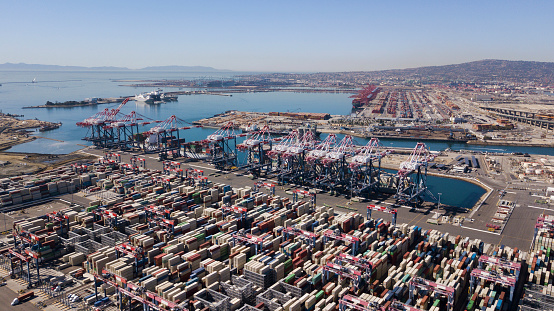-
Port of Los Angeles ends the first quarter of 2023 with a total of 1,837,094 TEUs after March volume reached 623,234 TEUs in March amid “freight recession”
-
The March throughput of restores LA Port to the No.1 status with a 620,487-TEU edge over its rival, Port of New York and New Jersey
-
Port of LA executive director Gene Seroka is optimistic of an upturn as signs appear, including nine consecutive months of declining inflation
Port of Los Angeles processed 623,234 twenty-foot equivalent units (TEUs) of cargo in March, closing out a soft first quarter weakened by what industry analysts call a “freight recession,” but putting back LA Port on top of the industry.
For the first three months, the perennial No.1 trade hub in North America handled 1,837,094 TEUs, down 32% from the same quarter in 2022, the best Q1 in its history, Port of Los Angeles executives said.
LA Port jumped to the top with a 620,487-TEU edge over its rival, Port of New York and New Jersey, after being dislodged in February by the biggest US East Coast gateway. Los Angeles first lost the crown to its rival in August 2022 during a big shift by congestion-wary traders to the East Coast, but regained it in January.
“Economic conditions slowed global trade considerably in the first quarter; however, we are beginning to see some signs of improvement, including nine consecutive months of inflation declines,” said Port of LA executive director Gene Seroka.
“While March cargo volume was lower than last year at this time, early data and monthly growth indicates a moderate increase in Q3.”
Seroka announced the Q1 data at a media briefing joined by Volvo Trucks North America president Peter Voorhoeve, who outlined his firm and the port’s work to bring zero-emission, heavy-duty trucks to market.
Volvo, along with other original equipment manufacturers, are collaborating with Port of LA to achieve a goal of transitioning the gateway’s drayage fleet to zero emission by 2035.
On April 11, analysts interviewed on The Freight Buyers’ Club podcast on April 11 said the post-Covid US trade slowdown is impacting demand for household goods far more seriously than industrial freight demand in a “freight recession”.
This explains why, since H2 2022, the trans-Pacific container freight rates and demand dropped far more significantly than on the trans-Atlantic and why domestic trucking and air cargo markets have turned bearish, the analysts said.
RELATED READ: LA Port volume lowest in 3 years
Jason Miller, interim chairperson of the Department of Supply Chain Management at Michigan State University’s Eli Broad College of Business, said the US economy is not displaying any serious “red flag indicators” that an economic recession is imminent. Rather, it is suffering “a freight recession” that is affecting logistics and shipping lanes in varied ways, he said.
Miller said US credit card delinquency rates were still below pre-Covid rates, mortgage delinquency rates were falling, wage growth was “very robust” and demand across key parts of the economy, including motor vehicles, parts and heavy equipment,” was performing well.
But demand for imported non-industrial products typically shipped by container or via air freight solutions such as clothing, computers, phones and furniture had significantly fallen .
“Anything single family housing-related has been very much hit by this huge cool-down of housing activity of roughly 30% from this time last year,” said Miller. This is one reason why the US trucking market has been in recession since the third quarter of 2022, he said.
This situation also helps explain why the westbound trans-Atlantic container shipping market has been performing far better than imports to the US from Asia, said Judah Levine, head of research at Freightos.
Levine said the freight recession was partly due to heavy imports in H1 2022 that left many retailers huge inventories. But, he added, this had impacted the trans-Pacific headhaul market far more than US imports from Europe.
Although trans-Atlantic rates have fallen around 50% since their peak earlier this year, Levine said the decline had been far less severe than on the trans-Pacific, where spot rates had collapsed. This was so because the two trades were driven by different types of imports.
“When we talk about the trans-Pacific, it’s consumer goods,” he said, adding that people are buying now very different items from those during the pandemic, when bulky household goods were in high demand.









